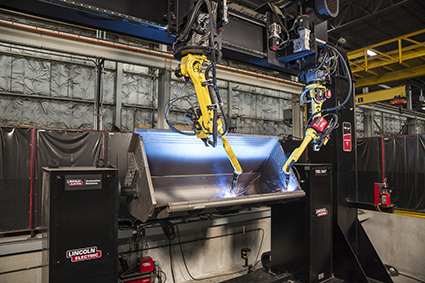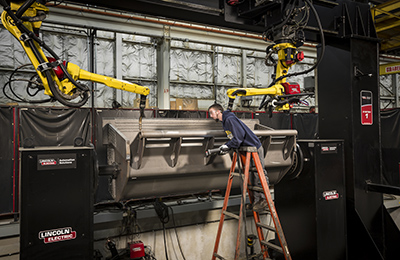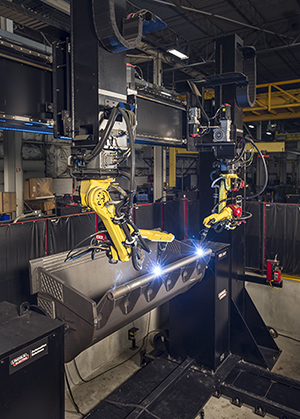ACS EXPANDS ITS MARKET OPPORTUNITIES WITH A GANTRY ROBOT DEVELOPED IN PARTNERSHIP WITH LINCOLN ELECTRIC
ACS bucket attachment welded robotically
Since 1968, ACS Industries has been in the business of providing attachments for large-scale earth moving and construction equipment. In the aftermath of the recessionary economy of 2008 and 2009, the company was ready to dig deeper and build a more enduring presence in new markets. A robotic system designed in collaboration with Lincoln Electric helped to make it happen.
Located in a 100,000-square-foot facility in Kent, Ohio, ACS Industries is a provider of construction attachments in the construction equipment industry. ACS is a fabricator of a variety of work tools – buckets, forks, blades, couplers and other implements – that construction vehicles utilize for various digging, clearing, demolition and mining processes.
ACS has enjoyed a number of firsts in the construction equipment industry, including the introduction of attachment changeover technology. This innovation – along with the introduction of the first single-point, self-aligning wheel loader coupler system, the first front-locking excavator coupler system and a bucket with a monolithic floor design for the hot slag industry – has kept ACS at the forefront of its industry in providing innovation and value to its customers.
The ACS customer base is primarily North American, although they do a small amount of international business (about 5 percent of their overall sales). A substantial and growing portion of the company’s business includes the U.S. military. Since the late 1980s, ACS has made heavy material handling equipment used by the United States Marine Corps throughout the world.
New Channels, New Opportunities
Like most companies, regardless of industry, ACS emerged from the widespread recession of 2008 on a landscape that had changed dramatically. And like most companies, ACS entered an adjustment phase around 2011 and 2012, says Joe Zeno, CEO at ACS.
“We were in the process of redeveloping our business plan, identifying the opportunities,” says Zeno. “We always identify opportunities around pain. If we can understand what the pain is, and come up with a better solution, that’s an opportunity. It was during that period that we looked at our channels of distribution in the marketplace and we said, ‘We need to broaden those channels. We need to do a better job ofcontrolling our message and getting it to the end user.’”
As a result, ACS reorganized into two primary business channels: product line and engineered product. Product line includes tools for standard construction activities: site clearing, underground water and sewer development, road building and the like. Engineered product focuses on more specialized implements for industries such as aggregate mining and steelmaking.
ACS already had robotic systems online to address their product line, but engineered product was something new. “We had only played in that market sparingly,” says Zeno, “and we knew that if it was a direction we wanted to take, that there were other competitors, and that if we were going to gain market share, we had to have a better value proposition for our customers. This proposition was developed to provide more innovative products, reduced delivery lead times, and lower costs of acquisition and operation. And it became very apparent very quickly that the only way to achieve that was through the development and utilization of robotic technology in this segment of our business.”
ACS employee prepares attachment for welding
ACS may have recognized the mission, but the company was not clear on the path. They contacted four robotic welding technology providers for assistance.
“Of course, the evaluation that most people would do is, ‘How much is this going to cost?’” says ACS President Bob Willoughby. “And admittedly, that was a big consideration. But we did not necessarily go with the cheapest option. We went with what we felt would bring us the biggest value to our company, our customers and our employees. During that process, we evaluated a lot of different avenues: What will this piece of equipment do for us? Is it going to do exactly what we think it’s going to do?
It became clear fairly quickly that Lincoln Electric offered clear advantages over its competitors in experience and available solutions. The collaborative process of system development and design took many meetings over almost six months, but the successful team effort led to the official launch of the project.
We had a range of equipment that we wanted to run on that robot, and Lincoln stepped up,” Willoughby adds. “We sent drawings and files back and forth, and they never wavered. We never heard them say, ‘Well, we don’t know whether we can do this.’”
The assistance from Lincoln during the implementation process “was day to day, hour to hour, minute to minute,” says Zeno. “Every time we picked up the phone to collaborate in one form or another, Lincoln was there. And if they didn’t quite have the answer, they were great at saying, ‘Hey, we’ll work on this together and we’ll get the answer.’ This robot is a big investment, and when you make an investment like this, you really need to think about who your partner is going to be. And I think that we were quite pleased when we selected Lincoln as our vendor. We were quite pleased throughout the process, and we’re quite pleased today as well. We still consider Lincoln a valuable partner, not only on this project, but on other things we’re doing. And we believe that we’re gaining a lot of traction in the marketplace.”
Robotic welding system with overhead crane mounted in a five-foot deep pit
One System, Many Welds
The result of the consultation and planning was an overhead gantry system with two Fanuc® robotic arms. Initially developed in the latter half of 2013, the system is designed to weld large buckets – up to 22 cubic yards, and as much as 28,000 pounds – that are used in quarries and steel mills.
The entire assembly was mounted in a five-foot deep pit – 40 feet long by 20 feet wide – dug into the ACS factory floor to keep the robot’s 26-foot height under the overhead crane. The system welds the bucket in six different axes, with a variety of wire diameters at each axis, starting with as little as 0.035 and going up to 1/16-inch wire.
“We will do anywhere from 3/8-inch fillet welds to one-inch groove welds that require multiple-pass,” says Willoughby. “Anything above 3/8-inch are all multiple-pass welds that require multiple movements and multiple programs in the machine in all of those axes.”
“In many of our buckets we are welding two different grades of materials, which requires two different processes,” says Willoughby. “Lincoln has helped us develop those processes and select the wire and gas that is required to weld the different grades of steels that we use in these buckets. So it isn’t a process where you just stick a bucket up there and you have one wire. The machine has to pause, we have to change to the proper wire, and again, working with the Lincoln Electric team, we’ve been very successful at that.”
And given the rigorous demands of the buckets’ end use, quality and precision are paramount concerns, says Willoughby.
“These buckets are digging at the face of a granite wall, or they could be handling molten slag at 2800 degrees out of the furnace,” he explains. “So the welding of these products is critical and ultimately impacts how they perform.” While the development of processes and procedures is ongoing, initial results are exceeding expectations. Non-value-added labor has been reduced, and consistency of quality has improved.
Finished bucket attachment
“We know how much time these buckets take us to weld manually, and we know how much time they’re parked on our factory floor,” says Zeno. “Instead of parking there for five weeks, as they have in the past when we were welding them strictly on a manual basis, they’re usually only there for a matter of days. So the reduction in non-value-added labor is significant. It exceeds 60 percent. That’s enabled us to offer quality products in a very price-competitive way, and in most cases at a significant pricing advantage over our competitors.”
In addition, implementation of the robot has boosted efficiency by reducing labor costs. “Our efficiency has gone from about 60 percent to 80 percent,” says Willoughby. “We’re obviously aiming for 100 percent. I don’t know that it’s possible to ever maintain 100 percent on a continuing basis, but it’s a goal that we continue to work toward.”
More importantly, ACS believes the introduction of this technology has made a statement about the level of quality and service the company is prepared to provide to its customers. The results have been multi-layered: increased growth and profitability in its existing business, as well as new opportunities in yet-untapped markets which for ACS has resulted in a bucket development program with a major OEM increasing bucket orders by $1,500,000 to date and accelerated sales growth into both the aggregate mining and steel production industries.
Completed bucket being loaded for delivery to end user
A Partnership For The Future
Integrating the gantry robot with their existing processes took time and persistence. “We’re still in that learning phase,” says Zeno, “but we’ve covered a lot of ground, and we’re beginning to see the real tangible benefits of all the work that’s gone into this activity.”
Even with the system up and running, Lincoln Electric continues to provide guidance, support and fine tuning in response to ACS’s processing needs and the changing demands of the industry.
“Things continue to change,” says Zeno. “The things that you put to bed today may not necessarily be put to bed tomorrow. We take great comfort in knowing we have a resource like Lincoln Electric as our partner. Lincoln is a world-class company with world class professionals. They have the resources that we can plug into and get quick and helpful responses. So our plan is to continue that partnership. Hopefully down the road, if our business continues to grow in a way we believe it will, there’s going to be a need for additional equipment and robots. With our past success as a great foundation, ACS and Lincoln Electric will be able to capitalize upon all of the things we’ve learned collectively on this robot into the things we’re planning for the future.”





